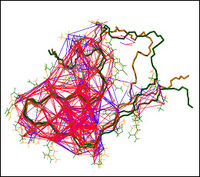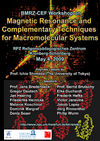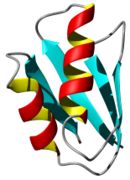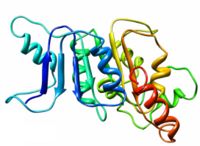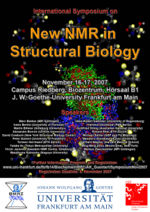News
(→Seminar by Prof. Koichi Kato (03.07.2008)) |
|||
| (89 intermediate revisions by 5 users not shown) | |||
| Line 1: | Line 1: | ||
| + | [[#2011|2011]] | ||
| + | [[#2010|2010]] | ||
| + | [[#2009|2009]] | ||
| + | [[#2008|2008]] | ||
| + | [[#2007|2007]] | ||
| + | |||
| + | == 2011 == | ||
| + | |||
| + | === BMRZ Seminar by Prof. Alexander Arseniev === | ||
| + | 3.3.2011 | ||
| + | |||
| + | from 15:00 in room H2 | ||
| + | |||
| + | '''NMR study of membrane protein helix-helix interactions''' | ||
| + | |||
| + | ''Prof. Alexander Arseniev, Institute of Bioorganic Chemistry, Russian Academy of Sciences, Moscow'' | ||
| + | |||
| + | |||
| + | == 2010 == | ||
| + | |||
| + | === BMRZ Seminar by Prof. Beat H. Meier and Dr. Anja Böckmann === | ||
| + | [[image:Meier_Boekmann.jpg|thumb|200px]] | ||
| + | 25.11.2010 | ||
| + | |||
| + | from 15:00 in room N100 0.15 | ||
| + | |||
| + | '''Protein structures by solid-state NMR: Recent progress''' | ||
| + | |||
| + | ''Prof. Beat H. Meier, Physical Chemistry, ETH Zürich'' | ||
| + | |||
| + | Structure determination from solid-state NMR spectra is still a challenge. While a handful of proteins have indeed been solved at atomic resolution, structure determination of completely unknown proteins and of larger proteins (>150 residues) is still difficult and prone to error. The talk will describe some of the problems and pitfalls and sketch or describe some recipes that promise to advance the field in the future. These include better and more efficient pulse sequences, enhanced spectral resolution, four-dimensional spectroscopy, and improved computational processes to arrive at the correct structure form a set of given solid-state spectra. The principles will be illustrated using microcrystalline proteins as well as fibrils. | ||
| + | |||
| + | |||
| + | '''Solid-state NMR structural studies of prions''' | ||
| + | |||
| + | ''Dr. Anja Böckmann, CNRS-UMR, Lyon, France'' | ||
| + | |||
| + | Prions are infectious, self-propagating polymers of otherwise soluble, host-encoded proteins. The structural basis of prion infectivity remains largely elusive today; this issue is a technical challenge as prion oligomers are heterogeneous high molecular weight particles that are neither suitable for protein crystallography nor classical NMR studies. Moreover, it has long been believed that misfolded proteins like prions and amyloids give poorly resolved NMR spectra. We show that the spectra of full-length prion fibrils from Ure2p and HET-s interestingly lead to very highly resolved solid-state NMR spectra, at least for parts of the proteins. Ure2p and HET-s are of similar architecture, with a compactly folded globular domain and an in solution flexible prion domain. Comparing the NMR spectra of the full-length protein fibrils reveals however surprising features and stresses the structural diversity underlying prion propagation suggesting that no unique mode exists for the assembly of these proteins into fibrils. | ||
| + | |||
| + | === e-NMR - Extend-NMR Workshops in Vilnius (Lithuania) === | ||
| + | |||
| + | 04-08.10.2010 | ||
| + | |||
| + | '''NMR structure calculation - GRID applications and integrated tools ''' | ||
| + | |||
| + | For more information, please see the following webpage of the [http://www.enmr.eu/eNMR-news-events Workshop]. | ||
| + | |||
| + | |||
| + | === BMRZ Seminar by Prof. Masatsune Kainosho === | ||
| + | |||
| + | 02.07.2010 | ||
| + | |||
| + | '''Recent progress in SAIL-NMR methods for studying Protein Structure and Dynamics''' | ||
| + | |||
| + | ''Prof. Masatsune Kainosho, Nagoya University and Tokyo Metropolitan University'' | ||
| + | |||
| + | |||
| + | === e-NMR - Extend-NMR Workshops in Vilnius (Lithuania) === | ||
| + | |||
| + | 07-11.06.2010 | ||
| + | |||
| + | '''NMR structure calculation - GRID applications and integrated tools ''' | ||
| + | |||
| + | For more information, please see the following webpage of the [http://www.enmr.eu/eNMR-news-events Workshop]. | ||
| + | |||
| + | |||
| + | === 4<sup>th</sup>BMRZ-CEF Workshop === | ||
| + | |||
| + | 16.04.2010 | ||
| + | |||
| + | 4<sup>th</sup>BMRZ-CEF Workshop will be held on 16 April 2010 in Forschungskolleg Humanwissenschaften in Bad Homburg. For details, see the [http://www.bmrz.uni-frankfurt.de/wiki/index.php/BMRZ_meeting_2010 Meeting website]. | ||
| + | |||
== 2009 == | == 2009 == | ||
| − | === | + | === BMRZ Seminar by Prof. Vladislav Orekhov === |
| − | : | + | 10.12.2009, 16:00, Biocenter Lecture Hall B2 |
| − | + | '''Co-processing NMR spectra with multi-dimensional decomposition: 4D NOESYs of the human membrane protein VDAC-1 and other applications''' | |
| − | + | ''Prof. Vladislav Orekhov, Swedish NMR Centre, University of Gothenburg, Sweden'' | |
| − | :Wasmer, C. Lange, A., Van Melckebeke, H., Siemer, A. B., Riek, R. & Meier, B. H. (2008). Amyloid fibrils of the HET-s(218–289) prion form a β solenoid with a triangular hydrophobic core. Science 319, 1523–1526. | + | The analysis of typical sets of multidimensional NMR experiments for signal assignment, structure calculations, and metabolomic studies relies on matching of signal frequencies between several experiments. By simultaneous processing of the spectra, this intrinsic reoccurrence of signal frequencies and line-shapes is exploited to enhance the quality and efficiency of the data analysis. We use multi-dimensional decomposition (MDD) for co-processing of any combination of experiments and non-uniform sampling for optimizing spectra resolution and sensitivity. The approach has been successfully demonstrated for several essentially different situations: processing of 4D NOESY spectra for the de novo structure determination of the 31 kDa integral human membrane protein VDAC-1 in detergent micelles with an effective molecular weight of 70–90 kDa; rapid real-time data collection and automated backbone assignments of a 13 kDa naturally disordered cytoplasmic part of the zeta-chain of the T-cell receptor system; a metabolomic study on food-deprived fish. |
| + | |||
| + | * Hiller, S., Garces, R.G., Malia, T.J., Orekhov, V.Y., Colombini, M. & Wagner, G. Solution structure of the integral human membrane protein VDAC-1 in detergent micelles. [http://dx.doi.org/10.1126/science.1161302 Science 321, 1206-1210 (2008)] | ||
| + | * Jaravine, V.A. and Orekhov, V.Y. Targeted acquisition for real-time NMR spectroscopy. [http://dx.doi.org/10.1021/ja062146p J. Am. Chem. Soc. 128, 13421-13426 (2006)] | ||
| + | |||
| + | |||
| + | === Job announcement === | ||
| + | |||
| + | 22.6.2009 | ||
| + | |||
| + | '''Ph.D. and postdoctoral positions in "Hyper-dimensional NMR spectroscopy for automated protein structure determination" | ||
| + | |||
| + | [[Ph.D. and postdoctoral positions in hyper-dimensional NMR| Read more...]] | ||
| + | |||
| + | |||
| + | [[image:BMRZ-CEFPoster3small.jpg|thumb|100px]] | ||
| + | === BMRZ-CEF Workshop 2009 === | ||
| + | |||
| + | 04.05.2009 | ||
| + | |||
| + | The BMRZ and the [http://www.cef-mc.de/ Cluster of Excellence Macromolecular Complexes] at the Goethe University Frankfurt (CEF) held a joint [http://www.bmrz.uni-frankfurt.de/wiki/index.php/BMRZ-CEF_Workshop_2009 BMRZ-CEF Workshop 2009] on '''Magnetic Resonance and Complementary Techniques for Macromolecular Systems''' in Kronberg on May 4, 2009. For details, see the [http://www.bmrz.uni-frankfurt.de/wiki/index.php/BMRZ-CEF_Workshop_2009 BMRZ-CEF Workshop 2009 Workshop webpage]. | ||
| + | |||
| + | |||
| + | === BMRZ Seminar by Prof. Yuichiro Maéda === | ||
| + | |||
| + | 24.04.2009 | ||
| + | |||
| + | '''Towards understanding the basic properties of F-actin based on high resolution structures''' | ||
| + | |||
| + | ''Prof. Dr. Yuichiro Maéda, Structural Biology Research Center and Department of Biology, Nagoya University, Japan'' | ||
| + | |||
| + | Actin plays various important cellular roles, among others, in muscle contraction, cell motility, neuron network formation, and cell division. In muscle, the actin filament plays the central roles in muscle contraction and its regulation. In non-muscle cells, actin is highly dynamic through transition between monomeric G-actin and filamentous F-actin. Movement is driven and force is exerted by “tread-milling”; simultaneous polymerization at the B-end and depolymerization at the P-end of F-actin. F-actin elongation is not controllable so that F-actin cannot be crystallized. Therefore a high- resolution structure of F-actin has never been known. Recently, we have made progress in the structural elucidation of F-actin. First, we have obtained a high-resolution structure of F-actin (Oda et al., 2009), which is based upon X-ray fiber diffractions obtained from highly oriented F-actin sols. Second, we have established a method for knowing cryo-EM structures at the ends of F-actin, and by employing this method, we have obtained the structure of a capping protein bound to the B-end of F-actin. Third, we have challenged a long-lasting problem and we have established a Sf9 based actin expression system to prepare actin variants. This enables us to know more details of how actin works. By combining these results, we are beginning to understand how actin works. | ||
| + | |||
| + | * Oda, T., Iwasa, M., Aihara, T., Maéda, Y., Narita, A. The nature of the globular- to fibrous-actin transition. Nature 457, 441-446 (2009). | ||
| + | |||
| + | |||
| + | === BMRZ CCPN Workshop === | ||
| + | |||
| + | 17-18.02.2009 | ||
| + | |||
| + | A two day [http://www.ccpn.ac.uk/ccpn CCPN] (Collaborative Computing Project for NMR) workshop will take place February 17-18 (2009), right here at the BMRZ (rooms to be announced). It is free. The workshop will consist of a full Analysis workshop on day 1, and an integration workshop on day 2 (which would be more specialised, and/or possibly answering specific other questions that people might have (e.g. left over from day 1).For those of you who have not heard of this software, it is for assigning and analysing NMR spectra, and one of many nice features is that it can read many file list formats (Xeasy, pdb, NMRStar, Bruker, Cara, Sparky, nmrPipe...), making it easy to incorporate results obtained elsewhere into a project.The software has enjoyed a huge growth in the last years, and is very well supported. It is free to download, and runs on Windows, Linux and Apple PCs. There is an emailing list which is very lively, and the programmers even take suggestions to add to the software package. Furthermore, a nice [http://www.protein-nmr.org.uk/ web page] which goes through NMR experiments and assignments, by Vicky Higman, is oriented towards CCPN software. | ||
| + | |||
| + | |||
| + | [[image:InCellStructure.jpg|thumb|130px]] | ||
| + | === "Proteinstruktur in der lebenden Zelle bestimmt - NMR-Experimente erstmals in natürlicher Umgebung möglich" === | ||
| + | |||
| + | 05.03.2009 | ||
| + | |||
| + | [http://www.muk.uni-frankfurt.de/pm/pm2009/0309/041/ Pressemitteilung] by the [http://www.uni-frankfurt.de/ Goethe University Frankfurt am Main]. | ||
| + | |||
| + | * Sakakibara, D., Sasaki, A., Ikeya, T., Hamatsu, J., Hanashima, T., Mishima, M., Yoshimasu, M., Hayashi, N., Mikawa, T., Wälchli, M., Smith, B. O., Shirakawa, M., Güntert, P. & Ito, Y. Protein structure determination in living cells by in-cell NMR spectroscopy. [http://dx.doi.org/10.1038/nature07814 Nature 458, 102-105 (2009)] | ||
| + | |||
| + | |||
| + | === "Proteine bei der Arbeit beobachten" === | ||
| + | |||
| + | 05.03.2009 | ||
| + | |||
| + | [http://www.volkswagenstiftung.de/service/aktuelles/archiv/period/1240329274///article/145/proteine-bei.html Pressemitteilung] by the [http://www.volkswagenstiftung.de/ Volkswagen Foundation]. | ||
| + | |||
| + | * Sakakibara, D., Sasaki, A., Ikeya, T., Hamatsu, J., Hanashima, T., Mishima, M., Yoshimasu, M., Hayashi, N., Mikawa, T., Wälchli, M., Smith, B. O., Shirakawa, M., Güntert, P. & Ito, Y. Protein structure determination in living cells by in-cell NMR spectroscopy. [http://dx.doi.org/10.1038/nature07814 Nature 458, 102-105 (2009)] | ||
| + | |||
| + | |||
| + | === BMRZ Seminar by Dr. Hélène Van Melckebeke === | ||
| + | |||
| + | 16.01.2009 | ||
| + | |||
| + | '''High resolution structure of the HET-s(218-289) prion amyloid fibrils using solid-state NMR''' | ||
| + | |||
| + | ''Dr. Hélène Van Melckebeke, ETH Zürich'' | ||
| + | |||
| + | Prions and amyloid fibrils are associated with several animal and human diseases. Despite the paramount importance of the structural aspects, no atomic resolution structure of a prion in its fibrillar state has been reported yet. Solid-state NMR is to date the only technique capable of obtaining the structure of such non-crystalline and non-soluble compounds. We have obtained the structure of amyloid fibrils produced in vitro from the prion-forming domain (residues 218-289) of the HET-s prion from the filamentous fungus Podospora anserina using solid-state NMR techniques. These results give a structural explanation of the stability of the HET-s(218-289) fibrils. In the presentation, both methodological and structural aspects will be discussed. | ||
| + | |||
| + | * Wasmer, C. Lange, A., Van Melckebeke, H., Siemer, A. B., Riek, R. & Meier, B. H. (2008). Amyloid fibrils of the HET-s(218–289) prion form a β solenoid with a triangular hydrophobic core. Science 319, 1523–1526. | ||
== 2008 == | == 2008 == | ||
| − | === | + | === BMRZ Seminar by Prof. Masatsune Kainosho === |
| − | + | 14.10.2008 | |
| − | + | '''Recent progress in the SAIL approach to study side-chain conformations of proteins and protein complexes''' | |
| − | + | ''Prof. Dr. Masatsune Kainosho, Nagoya University and Tokyo Metropolitan University, Japan'' | |
| − | |||
| − | + | === BMRZ Seminar by Dr. Hideo Iwai === | |
| − | + | 15.09.2008 | |
| − | + | '''Segmental and fractional isotopic labelling of proteins''' | |
| − | ===== | + | ''Dr. Hideo Iwai, University of Helsinki, Finland'' |
| + | |||
| + | Dr. Iwai will present two new approaches of segmental isotopic labelling and fractional <sup>13</sup>C labelling for NMR assignments of proteins. Recently, he has developed a robust approach for segmental isotopic labelling using protein trans-splicing, which could open possibilities to study a domain of intact proteins without dissecting into smaller globular domains. He will also present a novel concept to classify residue types in NMR spectra by the use of fractional labeling, which is distinct from routinely used chemical shifts and spin topologies for identifying residue types. | ||
| + | |||
| + | |||
| + | [[image:Pannenhelfer.jpg|thumb|200px]] | ||
| + | === "Pannenhilfe der Antibiotikumproduktion entschlüsselt" === | ||
| + | |||
| + | 11.08.2008 | ||
| + | |||
| + | [http://www.volkswagenstiftung.de/service/aktuelles/archiv/period/1233149134///article/145/pannenhilfe.html Pressemitteilung] by the [http://www.volkswagenstiftung.de/ Volkswagen Foundation]. | ||
| + | |||
| + | [http://www.muk.uni-frankfurt.de/pm/pm2008/0808/148/ Pressemitteilung] by the [http://www.uni-frankfurt.de/ Goethe University Frankfurt am Main]. | ||
| + | |||
| + | * Koglin, A., Löhr, F., Bernhard, F., Rogov, V. R., Frueh, D. P., Strieter, E. R., Mofid, M. R., Güntert, P., Wagner, G., Walsh, C. T., Marahiel, M. A. & Dötsch, V. Structural basis for the selectivity of the external thioesterase of the surfactin-synthetase. [http://dx.doi.org/10.1038/nature07161 Nature 454, 907–911 (2008)] | ||
| + | |||
| + | |||
| + | === BMRZ Seminar by Prof. Koichi Kato === | ||
| + | |||
| + | 03.07.2008 | ||
'''NMR and sugar library approaches for structural glycomics''' | '''NMR and sugar library approaches for structural glycomics''' | ||
| − | + | ''Prof. Dr. Koichi Kato, Nagoya City University, Nagoya, and Institute of Molecular Science, Okazaki, Japan'' | |
| + | |||
| + | Many proteins in the living systems are covalently linked to carbohydrate moieties. NMR spectroscopy can potentially provide information on the structure and dynamics of glycoproteins in solution but has also been hampered by spectral overlap and low sensitivity. To cope with this difficulty, we have been developing a systematic method for structural glycobiology by combined use of stable-isotope-assisted NMR spectroscopy and multi-dimensional HPLC techniques for glycosylation profiling and sugar library construction. Our projects address the underlying mechanisms of | ||
| + | * Glycoform-dependent effector functions of immunoglobulin G glycoproteins as therapeutic antibodies | ||
| + | * Glycoprotein-fate determination in cells through the interactions with a variety of intracellular lectins | ||
| + | |||
| + | |||
| + | == 2007 == | ||
| + | |||
| + | [[image:NewNMRinStructuralBiology2007Poster.jpg|thumb|150px]] | ||
| + | === Symposium on New NMR in Structural Biology 2007 === | ||
| + | |||
| + | 16-17.11.2007 | ||
| − | : | + | For details, please see the [http://www.uni-frankfurt.de/fb/fb14/BiochemieH/BPC/AK_Guentert/SymposiumNov2007/index.html conference web site]. |
| − | + | ||
| − | + | ||
| − | + | ||
| − | + | ||
Latest revision as of 14:15, 21 February 2011
2011
BMRZ Seminar by Prof. Alexander Arseniev
3.3.2011
from 15:00 in room H2
NMR study of membrane protein helix-helix interactions
Prof. Alexander Arseniev, Institute of Bioorganic Chemistry, Russian Academy of Sciences, Moscow
2010
BMRZ Seminar by Prof. Beat H. Meier and Dr. Anja Böckmann
25.11.2010
from 15:00 in room N100 0.15
Protein structures by solid-state NMR: Recent progress
Prof. Beat H. Meier, Physical Chemistry, ETH Zürich
Structure determination from solid-state NMR spectra is still a challenge. While a handful of proteins have indeed been solved at atomic resolution, structure determination of completely unknown proteins and of larger proteins (>150 residues) is still difficult and prone to error. The talk will describe some of the problems and pitfalls and sketch or describe some recipes that promise to advance the field in the future. These include better and more efficient pulse sequences, enhanced spectral resolution, four-dimensional spectroscopy, and improved computational processes to arrive at the correct structure form a set of given solid-state spectra. The principles will be illustrated using microcrystalline proteins as well as fibrils.
Solid-state NMR structural studies of prions
Dr. Anja Böckmann, CNRS-UMR, Lyon, France
Prions are infectious, self-propagating polymers of otherwise soluble, host-encoded proteins. The structural basis of prion infectivity remains largely elusive today; this issue is a technical challenge as prion oligomers are heterogeneous high molecular weight particles that are neither suitable for protein crystallography nor classical NMR studies. Moreover, it has long been believed that misfolded proteins like prions and amyloids give poorly resolved NMR spectra. We show that the spectra of full-length prion fibrils from Ure2p and HET-s interestingly lead to very highly resolved solid-state NMR spectra, at least for parts of the proteins. Ure2p and HET-s are of similar architecture, with a compactly folded globular domain and an in solution flexible prion domain. Comparing the NMR spectra of the full-length protein fibrils reveals however surprising features and stresses the structural diversity underlying prion propagation suggesting that no unique mode exists for the assembly of these proteins into fibrils.
e-NMR - Extend-NMR Workshops in Vilnius (Lithuania)
04-08.10.2010
NMR structure calculation - GRID applications and integrated tools
For more information, please see the following webpage of the Workshop.
BMRZ Seminar by Prof. Masatsune Kainosho
02.07.2010
Recent progress in SAIL-NMR methods for studying Protein Structure and Dynamics
Prof. Masatsune Kainosho, Nagoya University and Tokyo Metropolitan University
e-NMR - Extend-NMR Workshops in Vilnius (Lithuania)
07-11.06.2010
NMR structure calculation - GRID applications and integrated tools
For more information, please see the following webpage of the Workshop.
4thBMRZ-CEF Workshop
16.04.2010
4thBMRZ-CEF Workshop will be held on 16 April 2010 in Forschungskolleg Humanwissenschaften in Bad Homburg. For details, see the Meeting website.
2009
BMRZ Seminar by Prof. Vladislav Orekhov
10.12.2009, 16:00, Biocenter Lecture Hall B2
Co-processing NMR spectra with multi-dimensional decomposition: 4D NOESYs of the human membrane protein VDAC-1 and other applications
Prof. Vladislav Orekhov, Swedish NMR Centre, University of Gothenburg, Sweden
The analysis of typical sets of multidimensional NMR experiments for signal assignment, structure calculations, and metabolomic studies relies on matching of signal frequencies between several experiments. By simultaneous processing of the spectra, this intrinsic reoccurrence of signal frequencies and line-shapes is exploited to enhance the quality and efficiency of the data analysis. We use multi-dimensional decomposition (MDD) for co-processing of any combination of experiments and non-uniform sampling for optimizing spectra resolution and sensitivity. The approach has been successfully demonstrated for several essentially different situations: processing of 4D NOESY spectra for the de novo structure determination of the 31 kDa integral human membrane protein VDAC-1 in detergent micelles with an effective molecular weight of 70–90 kDa; rapid real-time data collection and automated backbone assignments of a 13 kDa naturally disordered cytoplasmic part of the zeta-chain of the T-cell receptor system; a metabolomic study on food-deprived fish.
- Hiller, S., Garces, R.G., Malia, T.J., Orekhov, V.Y., Colombini, M. & Wagner, G. Solution structure of the integral human membrane protein VDAC-1 in detergent micelles. Science 321, 1206-1210 (2008)
- Jaravine, V.A. and Orekhov, V.Y. Targeted acquisition for real-time NMR spectroscopy. J. Am. Chem. Soc. 128, 13421-13426 (2006)
Job announcement
22.6.2009
Ph.D. and postdoctoral positions in "Hyper-dimensional NMR spectroscopy for automated protein structure determination"
BMRZ-CEF Workshop 2009
04.05.2009
The BMRZ and the Cluster of Excellence Macromolecular Complexes at the Goethe University Frankfurt (CEF) held a joint BMRZ-CEF Workshop 2009 on Magnetic Resonance and Complementary Techniques for Macromolecular Systems in Kronberg on May 4, 2009. For details, see the BMRZ-CEF Workshop 2009 Workshop webpage.
BMRZ Seminar by Prof. Yuichiro Maéda
24.04.2009
Towards understanding the basic properties of F-actin based on high resolution structures
Prof. Dr. Yuichiro Maéda, Structural Biology Research Center and Department of Biology, Nagoya University, Japan
Actin plays various important cellular roles, among others, in muscle contraction, cell motility, neuron network formation, and cell division. In muscle, the actin filament plays the central roles in muscle contraction and its regulation. In non-muscle cells, actin is highly dynamic through transition between monomeric G-actin and filamentous F-actin. Movement is driven and force is exerted by “tread-milling”; simultaneous polymerization at the B-end and depolymerization at the P-end of F-actin. F-actin elongation is not controllable so that F-actin cannot be crystallized. Therefore a high- resolution structure of F-actin has never been known. Recently, we have made progress in the structural elucidation of F-actin. First, we have obtained a high-resolution structure of F-actin (Oda et al., 2009), which is based upon X-ray fiber diffractions obtained from highly oriented F-actin sols. Second, we have established a method for knowing cryo-EM structures at the ends of F-actin, and by employing this method, we have obtained the structure of a capping protein bound to the B-end of F-actin. Third, we have challenged a long-lasting problem and we have established a Sf9 based actin expression system to prepare actin variants. This enables us to know more details of how actin works. By combining these results, we are beginning to understand how actin works.
- Oda, T., Iwasa, M., Aihara, T., Maéda, Y., Narita, A. The nature of the globular- to fibrous-actin transition. Nature 457, 441-446 (2009).
BMRZ CCPN Workshop
17-18.02.2009
A two day CCPN (Collaborative Computing Project for NMR) workshop will take place February 17-18 (2009), right here at the BMRZ (rooms to be announced). It is free. The workshop will consist of a full Analysis workshop on day 1, and an integration workshop on day 2 (which would be more specialised, and/or possibly answering specific other questions that people might have (e.g. left over from day 1).For those of you who have not heard of this software, it is for assigning and analysing NMR spectra, and one of many nice features is that it can read many file list formats (Xeasy, pdb, NMRStar, Bruker, Cara, Sparky, nmrPipe...), making it easy to incorporate results obtained elsewhere into a project.The software has enjoyed a huge growth in the last years, and is very well supported. It is free to download, and runs on Windows, Linux and Apple PCs. There is an emailing list which is very lively, and the programmers even take suggestions to add to the software package. Furthermore, a nice web page which goes through NMR experiments and assignments, by Vicky Higman, is oriented towards CCPN software.
"Proteinstruktur in der lebenden Zelle bestimmt - NMR-Experimente erstmals in natürlicher Umgebung möglich"
05.03.2009
Pressemitteilung by the Goethe University Frankfurt am Main.
- Sakakibara, D., Sasaki, A., Ikeya, T., Hamatsu, J., Hanashima, T., Mishima, M., Yoshimasu, M., Hayashi, N., Mikawa, T., Wälchli, M., Smith, B. O., Shirakawa, M., Güntert, P. & Ito, Y. Protein structure determination in living cells by in-cell NMR spectroscopy. Nature 458, 102-105 (2009)
"Proteine bei der Arbeit beobachten"
05.03.2009
Pressemitteilung by the Volkswagen Foundation.
- Sakakibara, D., Sasaki, A., Ikeya, T., Hamatsu, J., Hanashima, T., Mishima, M., Yoshimasu, M., Hayashi, N., Mikawa, T., Wälchli, M., Smith, B. O., Shirakawa, M., Güntert, P. & Ito, Y. Protein structure determination in living cells by in-cell NMR spectroscopy. Nature 458, 102-105 (2009)
BMRZ Seminar by Dr. Hélène Van Melckebeke
16.01.2009
High resolution structure of the HET-s(218-289) prion amyloid fibrils using solid-state NMR
Dr. Hélène Van Melckebeke, ETH Zürich
Prions and amyloid fibrils are associated with several animal and human diseases. Despite the paramount importance of the structural aspects, no atomic resolution structure of a prion in its fibrillar state has been reported yet. Solid-state NMR is to date the only technique capable of obtaining the structure of such non-crystalline and non-soluble compounds. We have obtained the structure of amyloid fibrils produced in vitro from the prion-forming domain (residues 218-289) of the HET-s prion from the filamentous fungus Podospora anserina using solid-state NMR techniques. These results give a structural explanation of the stability of the HET-s(218-289) fibrils. In the presentation, both methodological and structural aspects will be discussed.
- Wasmer, C. Lange, A., Van Melckebeke, H., Siemer, A. B., Riek, R. & Meier, B. H. (2008). Amyloid fibrils of the HET-s(218–289) prion form a β solenoid with a triangular hydrophobic core. Science 319, 1523–1526.
2008
BMRZ Seminar by Prof. Masatsune Kainosho
14.10.2008
Recent progress in the SAIL approach to study side-chain conformations of proteins and protein complexes
Prof. Dr. Masatsune Kainosho, Nagoya University and Tokyo Metropolitan University, Japan
BMRZ Seminar by Dr. Hideo Iwai
15.09.2008
Segmental and fractional isotopic labelling of proteins
Dr. Hideo Iwai, University of Helsinki, Finland
Dr. Iwai will present two new approaches of segmental isotopic labelling and fractional 13C labelling for NMR assignments of proteins. Recently, he has developed a robust approach for segmental isotopic labelling using protein trans-splicing, which could open possibilities to study a domain of intact proteins without dissecting into smaller globular domains. He will also present a novel concept to classify residue types in NMR spectra by the use of fractional labeling, which is distinct from routinely used chemical shifts and spin topologies for identifying residue types.
"Pannenhilfe der Antibiotikumproduktion entschlüsselt"
11.08.2008
Pressemitteilung by the Volkswagen Foundation.
Pressemitteilung by the Goethe University Frankfurt am Main.
- Koglin, A., Löhr, F., Bernhard, F., Rogov, V. R., Frueh, D. P., Strieter, E. R., Mofid, M. R., Güntert, P., Wagner, G., Walsh, C. T., Marahiel, M. A. & Dötsch, V. Structural basis for the selectivity of the external thioesterase of the surfactin-synthetase. Nature 454, 907–911 (2008)
BMRZ Seminar by Prof. Koichi Kato
03.07.2008
NMR and sugar library approaches for structural glycomics
Prof. Dr. Koichi Kato, Nagoya City University, Nagoya, and Institute of Molecular Science, Okazaki, Japan
Many proteins in the living systems are covalently linked to carbohydrate moieties. NMR spectroscopy can potentially provide information on the structure and dynamics of glycoproteins in solution but has also been hampered by spectral overlap and low sensitivity. To cope with this difficulty, we have been developing a systematic method for structural glycobiology by combined use of stable-isotope-assisted NMR spectroscopy and multi-dimensional HPLC techniques for glycosylation profiling and sugar library construction. Our projects address the underlying mechanisms of
- Glycoform-dependent effector functions of immunoglobulin G glycoproteins as therapeutic antibodies
- Glycoprotein-fate determination in cells through the interactions with a variety of intracellular lectins
2007
Symposium on New NMR in Structural Biology 2007
16-17.11.2007
For details, please see the conference web site.
